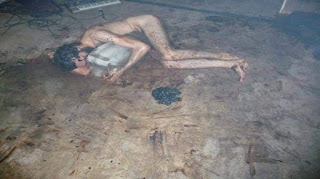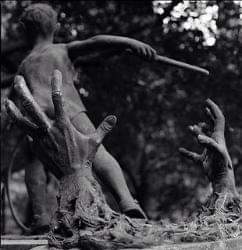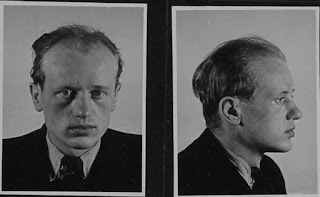This photograph shows a young Mother, exhausted from spending hours making matchboxes
This photograph shows a young Mother, exhausted from spending hours making matchboxes, a pile of which can be seen on the table.
London’s Working Class: 1870-1901
The Social Reformer Charles Booth was a wealthy man who campaigned for better conditions for the poorest workers in London. He commissioned photographers to take photographs of some of them to illustrate their plight. Here are a few of the photos he used to try to raise money to help them.
Making stone pipes during the Victorian era. Many women were employed to do this job, because they were paid less than men.
This photograph shows a young Mother, exhausted from spending hours making matchboxes, a pile of which can be seen on the table. At her feet is a young, sleeping baby covered by a blanket. For such homeworkers engaged in the sweated industries there was no division between work and home life. Match-box making was amongst the lowest paid work. The industry primarily employed women and children who could expect to work an average of 16 hours per day. For every 144 boxes made they received 2 pennies. This photograph appears in an album with a number of other prints depicting sweated labourers and London’s poor. Such albums were often compiled by charities to raise funds and inform the public about the plight of those living and working in London’s poorest areas, such as the East End.
An Italian Woman in a court in Saffron Hill, Clerkenwell, c.1901. This area was known as ‘Little Italy’, and was home to very poor Italian immigrants, many of whom worked at very low paid jobs such as taking in washing.
Another Italian family in the same area. The man has a business selling ice cream on the streets from his hand-cart.
A child ‘Boot Black’. Many young boys worked 12-16 hours a day on the streets, polishing shoes for a few pennies.
John Galt, a missionary and amateur photographer took this photograph of Mrs Robinson making mattresses outside her East End home. He photographed her at work, stuffing the mattresses with straw. For each completed mattress she would receive one shilling. John Galt was a missionary with the London City Mission. This photograph was one of many he produced to show conditions in the East End and the work of the mission. His photographic intention was often to show that, contrary to popular middle-class belief, the people of the East End were worthy of salvation.
A pub in South London, 1900. Most working men were paid on a daily basis, and it was common for them to go drinking in pubs on the way home, spending money that should have been for the upkeep of their families. Many Victorian reformers campaigned against the excessive use of alcohol by poor people, and urged them to join Temperance Leagues.
















Comments
Post a Comment